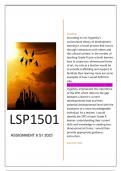PREVIEW
According to Lev Vygotsky's
sociocultural theory of development,
learning is a social process that occurs
through interactions with others and
the cultural context. In the context of
teaching Grade R (pre-school) learners
how to create two-dimensional forms
of art, my role as a teacher would be
to provide scaffolding and support to
facilitate their learning. Here are some
examples of how I would fulfill this
role:
Zone of Proximal Development (ZPD):
Vygotsky emphasized the importance
of the ZPD, which refers to the gap
between a learner's current
developmental level and their
potential developmental level with the
assistance of a more knowledgeable
individual. As a teacher, I would
LSP1501 identify the ZPD of each Grade R
learner, understanding their current
skills and knowledge in creating two-
dimensional art forms. I would then
provide appropriate guidance,
ASSIGNMENT 6 S1 2023 instruction…
NATALIE FOXX
, LSP1501/6/2023
VISUAL ARTS
Please use the layout and format provided below to structure your answers.
QUESTION 1
1.1 Study the pictures below and answer the question that follows.
Picture A Picture B
Compare the two images above. Distinguish between the two dimensions observed in
the images by clearly indicating which one is which and by explaining each. (4)
Picture A: This image features Rapunzel from "Rapunzel's Tangled Adventures."
In this image, Rapunzel is depicted holding a frog in one hand and drinking water
with her other hand. This suggests that the image is associated with the animated
television series "Rapunzel's Tangled Adventures."
Picture B: This image features Rapunzel from the movie "Tangled." Similar to the
previous image, Rapunzel is depicted holding a glass of water and drinking it.
Additionally, she is holding a frog in this image as well. This indicates that the
image is associated with the original "Tangled" movie.
Therefore, the main dimension observed in these images is the difference in the
source or context of the depicted scenes. Picture A represents Rapunzel from the
television series "Rapunzel's Tangled Adventures," while Picture B represents
Rapunzel from the movie "Tangled."
1
, WHATSAPP 0747160449
1.2 Drawing from your knowledge of Vygotsky’s theory, explain your role as a teacher when
teaching Grade R learners how to create two-dimensional forms of art. Support
your answer with appropriate examples. (6)
According to Lev Vygotsky's sociocultural theory of development, learning is a social
process that occurs through interactions with others and the cultural context. In the
context of teaching Grade R (pre-school) learners how to create two-dimensional forms
of art, my role as a teacher would be to provide scaffolding and support to facilitate
their learning. Here are some examples of how I would fulfill this role:
Zone of Proximal Development (ZPD): Vygotsky emphasized the importance of the
ZPD, which refers to the gap between a learner's current developmental level and their
potential developmental level with the assistance of a more knowledgeable individual.
As a teacher, I would identify the ZPD of each Grade R learner, understanding their
current skills and knowledge in creating two-dimensional art forms. I would then
provide appropriate guidance, instruction, and materials that align with their
developmental abilities, helping them progress within their ZPD. For example, I might
start by introducing basic shapes like circles and squares, and gradually move on to
more complex forms like animals or objects.
Scaffolding: Scaffolding refers to the temporary support provided to learners as they
develop new skills and knowledge. In the context of teaching two-dimensional art, I
would offer scaffolding by breaking down the artistic process into manageable steps
and providing demonstrations or visual aids. For instance, I might demonstrate how to
draw a basic shape and guide students in adding details to create a recognizable
object. As students gain confidence and skills, I would gradually reduce the level of
support, allowing them to work more independently.
Peer Collaboration: Vygotsky emphasized the importance of social interactions in
learning. I would encourage peer collaboration among Grade R learners, providing
opportunities for them to work together, share ideas, and learn from one another. For
instance, I might organize group art activities where students can collaborate on a
mural or work on individual pieces while discussing their progress and providing
feedback to each other.
Cultural and Artistic Context: Vygotsky's theory emphasizes the significance of cultural
context in learning. When teaching Grade R learners about two-dimensional art, I
would expose them to various cultural art forms and artists, helping them understand
and appreciate the diversity of artistic expression. For example, I might introduce them
to different styles of art, such as traditional African patterns or famous artists from
2




